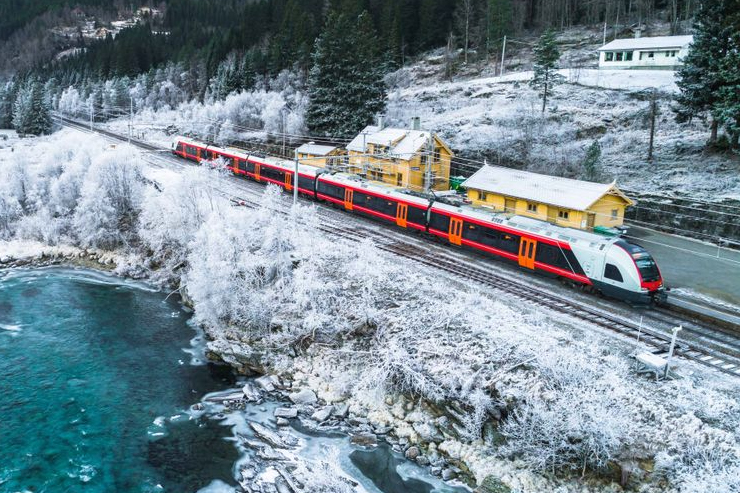Discovering Norway’s Scenic Majesty: Riding the Oslo-Bergen Railway

The highest rail route in Northern Europe On a chilly November morning in Oslo, I boarded a train bound for Bergen. I’ve been exploring Norway for more than a decade, returning at least a dozen times since my wide-eyed first trip. I have been to the northernmost point on the Norwegian mainland (Knivskjelodden) and to its southernmost tip (Lindesnes Fyr, where my sunglasses blew clean off my head and out to sea in a gale). I saw whales and walruses. I have hiked across glaciers in Svalbard and stood beneath the country’s only palm tree in Kristiansand. And I have watched the northern lights in winter and partied beneath the midnight sun in summer.
But for reasons passing all understanding, I had never before traveled the Oslo-Bergen railway. The more I thought about it, the stranger this seemed. This is, after all, ranked regularly among the world’s most beautiful train journeys. It was time – even long overdue.
Had done my research. I knew, for example, that on a short November day, only one of the five daily departure times, 08:25, would ensure that I made the entire six-and-a-half-hour, 496km journey during daylight hours. I knew enough also to book a window seat on the left side of the train (on the right if traveling from Bergen) to get the best views.
And when the train pulled away from the platform, I felt suddenly that, without realizing it until now, I had been waiting for this moment for a very long time.
At first, there was nothing to suggest the drama that lay ahead. As the train sped away from the city center, there were fleeting glimpses: of the pleasure craft of Oslofjord; of elegant wooden homes climbing hillsides; of signs to Bygdøy where museums told epic stories of exploration and the Viking past. Gathering speed out past Asker and Sandvika, the train then crossed the fjord and hurried past the burgeoning commuter city of Drammen, its hills colonized by the urban sprawl of the prettiest kind.
Not far west of Drammen, the track turned for the north. So expertly has this track been engineered that the change in direction barely registered. One minute we were traveling west, the next we were bound for the north and it was left to the landscape itself to announce the change: all of a sudden, the hills were higher, and pristine alpine meadows and pine-clad foothills scaled deep valleys studded with small villages and lone farmhouses clinging to precipices.
The change came gradually. The slowing train hinted at subtle gains in altitude. We entered a valley down by the shore of a pretty fjord. When we left, it was across a pass high above the valley floor; looking back to where we began, it all looked so terribly far down below. And then, without clear warning, we emerged from a tunnel and into the high snows of Hardangervidda, a vast mountain plateau.
“I love watching people’s faces when they travel this route for the first time,” Jørgen Johansen told me. Johansen has worked the line for Norway’s rail authorities for more than three decades. “I never get tired of the view, but it’s the look. Of wonder on people’s faces that I enjoy the most.”
With the train now atop Europe’s largest high plateau – Hardangervidda covers nearly 6,500 sq km, with an average elevation of more than 1km above sea level – the journey became something different altogether. For the first time, it rang true that this was both northern Europe’s highest mainline railway and a marvel of engineering.
One of the oldest geological formations on the continent’s north, Hardangervidda and its valleys and contours were shaped over millennia by glaciers gouging down off the icy wastes towards the sea. And yet, what took thousands of years under the weight of ice and the inexorable march of time, Norway’s rail and road builders accomplished in decades.
When the Bergensbanen (the Bergen Line), as it’s now sometimes called, was first surveyed in 1872, Norway was an impoverished outpost of a more prosperous Europe; the discovery of oil that would transform the country was still nearly a century away. At the time, there was much debate about where the money would come from, and there were many false starts; at the time, the export of sardines and herrings kept Norway’s national budget afloat, with not a lot left over for infrastructure projects on this scale.
Work nonetheless began on the line in 1875. By 1909, it was finished, its 39 stations (some of which are for local trains only – the inter-city service stops at 21) connected by a serpentine path across some of the most challenging landscapes you can imagine. Hardangervidda is notoriously inhospitable, its capricious changes in weather are just one challenge among many that faced the builders of the line. To make the railway work, to find the most direct route possible, they built 180 tunnels – one tunnel for every 2.75km of track.
“The Oslo-Bergen Railways tells a very Norwegian story,” Lisbeth Nielsen, a Norwegian transport historian told me later in Bergen. “There’s always something in the way when it comes to getting around Norway. If we let mountains or fjords stop us, we’d never go anywhere. So, they built tunnels and roads and railway lines that seemed impossible to everyone else. It’s part of what makes us Norwegian.”
By the time we got to the ski town of Geilo, the altitude was 794m and the journey’s midpoint. The world through which we traveled bore no resemblance to what went before it. Deep snow drowned the landscape and cross-country skiers left the train. And skied out off the platform and over the hills. High above Ustaoset (990m) and its ice-bound lake fringed with country cabins. A reindeer’s antlers stood silhouetted against the piercing blue sky; Norway’s biggest herd. Of wild reindeer, 10,000-strong still roams free across Hardangervidda. At Finse – the highest station along the line, at 1,222m above sea level – a group. Hikers in heavy winter gear boarded the train, ice still clinging to beards and boots. “This is my favorite part of the journey,” said Johansen. “Everything is drama, and up here on Hardangervidda is where the carriages always fall silent.”
He was right: no one spoke, and when the announcer broke the silence to announce our imminent. Arrival in Myrdal, I was not the only one who flinched at the sudden sound of a human voice.
At Myrdal Station (867m), a train waited on a branch line. That is one of the steepest railway lines on Earth. From Myrdal to Flåm, down by the banks of Aurlandsfjord. An inner arm of Sognefjord, the track twists and dives down through 20 tunnels. Losing 866m in altitude in just 20km, falling at a gradient of 1:18. There was, it seemed, nowhere that a Norwegian train couldn’t travel.
If the climb to Hardangervidda had seemed gradual, the descent to the town of Voss happened far too quickly. The snow thinned. The earth became green. And rivers, lakes, and then fjords were clear and blue. Here was yet another Norway, one where the track hugged one fjord after another. As it had since we had left Oslo hours earlier, the track both. Conquered the challenging topography and surrendered to it. There was no more pleasurable hour to be had in the entire journey than this final for-side meander.
And then, Bergen. The train wove between the seven hills and seven fjords of this graceful city. Whitewashed wooden buildings climbed the hillsides above the city center and autumn. Leaves gave the city a golden cast all the way into the stately, muralled train station. It was a fitting end to a remarkable journey, and, in the excitement of arrival. I felt as if I had just seen Norway for the very first time.





